Illustrated By Two Tibetan Paintings In The Museum.
There appears at first sight. little by which to distinguish the sacred paintings of Tibet from those of other Buddhist countries—China, Korea, or Japan. As a matter of fact, indeed, especially in matters of technique, the religious art of Tibet is essentially that of China under the Ming rulers (A.D. 1368-1644), when the simplicity of taste and the subordination of color to form, which had characterized the dynasty of “classic Sung,” were giving way to a more lavish use of pigment and a generally more elaborate and ornate style.
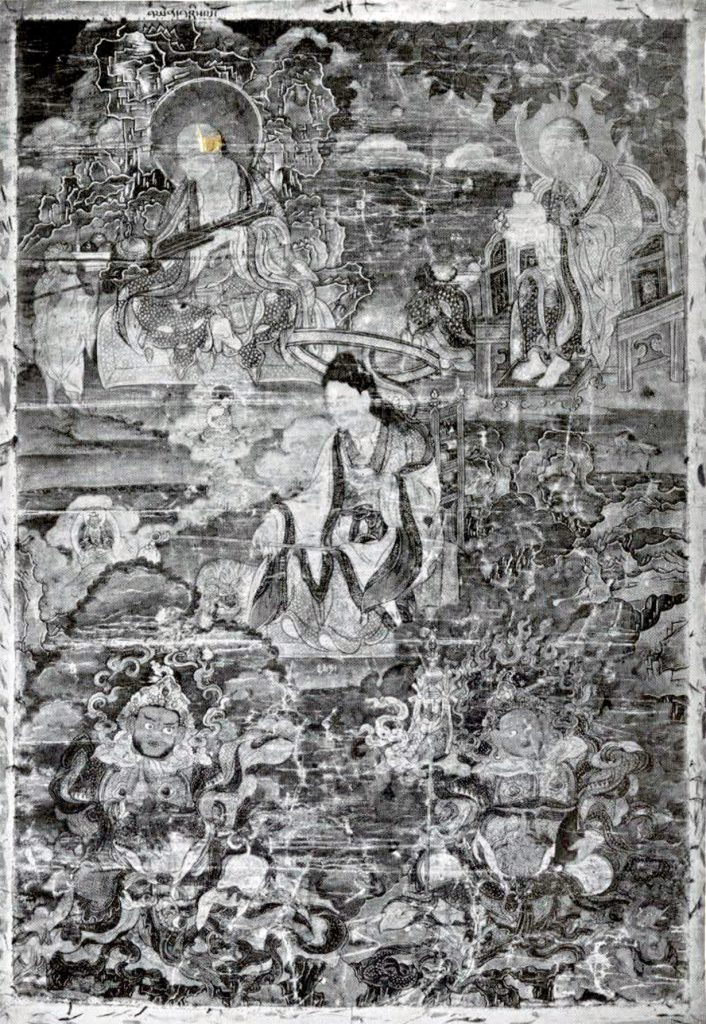
Museum Object Number: A1092
Image Number: 2163
Nevertheless, Tibetan sacred painting has developed certain well-marked characteristics which put it in a class of its own, This is due in part to the circumstance that Buddhism, when it entered Tibet, incorporated within itself many of the primitive beliefs and practices of the native shamanistic cult which it found in possession of the country, and in part to the fact that in matters of faith Tibet is more deeply indebted to India than to China. This applies in particular to the underlying principles and fundamentals. In regard to the way in which these are developed and depicted, as in most things pertaining to its material culture, Tibet has received a very strong impress from China. It will be the purpose of this paper to touch briefly upon some characteristics of Tibetan art, especially in so far as they are exemplified by the Tibetan paintings now on exhibition in the Museum.
The part played by ancient Greece in the development of art in Europe is matter of common knowledge. Few, however, realize that the influence of Hellas, stereotyped by the bonds of religious conservatism and much attenuated but none the less real, made itself felt in the opposite direction, even to the utmost hounds of Asia; and that, too, at a comparatively early date. The successors of the great Alexander managed to retain their hold upon the eastern extremity of his empire—eastern Afghanistan and northwestern British India—for some generations after the death of the conqueror, In time this political domination was overthrown by invading tribes from Central Asia; hut these, like the Romans before them, succumbed, in a measure at least, to the Greek standards of artistic beauty. They adopted at the same time the religion which had been developed from the simple teachings of the Buddha. It is to this combination of Buddhist faith and Greek art in an obscure corner of India that the religious sculpture and painting of half Asia owe their origin.
This art became conventionalized very early, and consequently many of the features which characterize it today date back directly to the period, two thousand years ago, when the influence of Greece was still predominant in the valley of the Indus. Among these features may be mentioned the use of the halo, for both Christian and Buddhist art seem to be indebted to pagan Greece for the use of the halo to distinguish persons of peculiar sanctity. The idea that gods and supernatural beings are either themselves luminous, or else surrounded by a luminous cloud, is constantly cropping out in the classical authors, Roman as well as Greek. Other characteristics due to the same influence are the wearing of a scarf over the left shoulder; the ushnîsha, originally merely a method of wearing the hair in a knot on the top of the head, but later transformed by common belief into an actual protuberance of the skull (one of the thirty-two lakshanas or “signs of auspiciousness” believed to occur upon the person of every genuine Buddha) ; the use of the wheel as a symbol of the sacred law; and the significance of the different positions of the hands. The crosslegged attitude so commonly met
with, as well as the use of the lotus in various symbolical connections, also date back to an extremely early period.
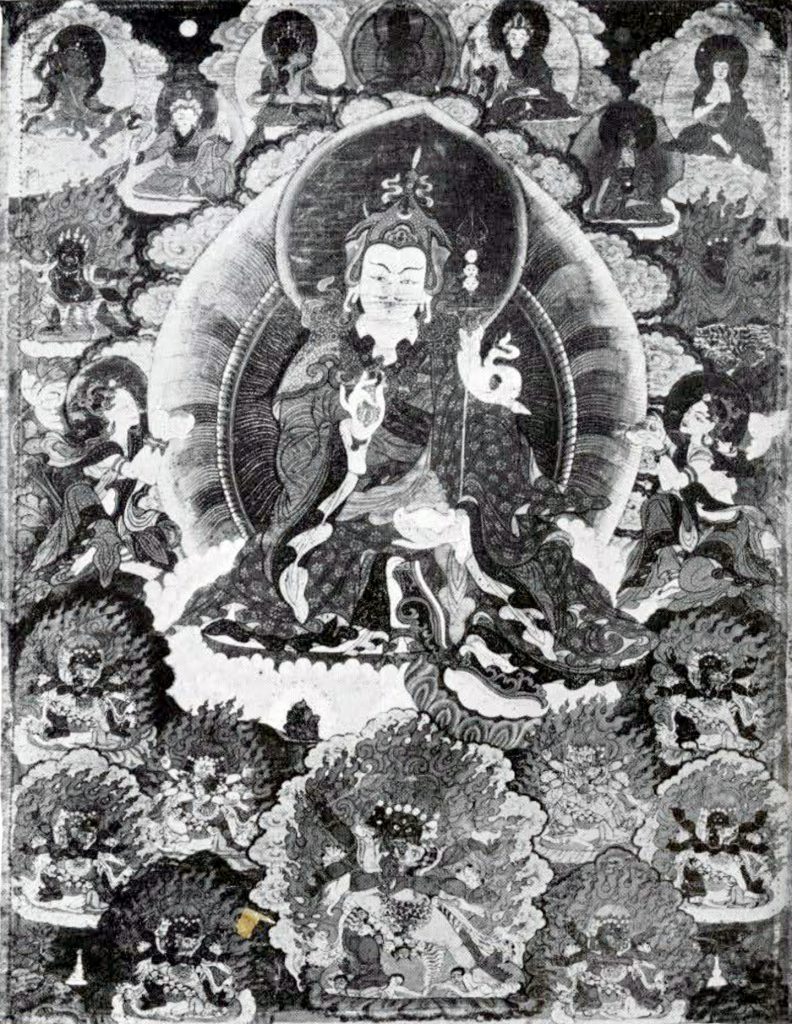
Museum Object Number: A1411
Image Number: 2164
Although a certain connection between the religious art of the Orient and that of the Occident thus really exists, the lines of development have diverged very widely in the two world areas. This is due to differences in the underlying motives; to the survival in the Orient of certain primitive modes of thought which have died out in the Occident; and to variations in the technique itself.
So far as motive goes, Buddhist art is primarily not aesthetic, but didactic. It is meant to assist in the explanation of religious truths to the unlettered masses, or to strange peoples, unable to read the sacred books. For this reason it has developed its symbolism to an extraordinary degree, in order that certain definite attributes may serve to fix their corresponding concepts firmly in the mind of the worshiper. Just as in classical mythology the eagle and the thunderbolt distinguish Jupiter, the owl, Minerva, and the trident, Neptune; and as in the Christian hagiology St. Mark has his winged lion, St. Lawrence his gridiron, and St. Peter his keys; so in like manner the various personages represented in Buddhist art may be distinguished according to the fixed attributes by which they are usually accompanied. The multiplicity of heads and arms and even of legs which may be mentioned in this connection does not, of course, imply that the Buddhist worshiper conceives of his divinities as actually possessing these forms. It is simply a symbolic way of conveying the idea that these beings are vastly superior to mankind in the variety and extent of their powers. The expression of extreme ferocity sometimes depicted upon the faces of certain classes of beings is no indication of their particularly malignant disposition, but, quite on the contrary, of their hostility toward evil. Where the Greeks strove to represent the qualities of their gods by indicating the perfection of their physical aspects, Buddhist art endeavors to do so by bringing out their spiritual qualities.
Among the survivals of primitive ideas in Oriental art may be mentioned the importance attached to the depicting of the eye. The story is told of a Chinese painter that he once portrayed a dragon with such supreme skill that no sooner had he completed the picture by painting in the eyes than the creature suddenly came to life and soared away amid smoke and thunder and flame, off into the clouds. In sacred art auspicious days are carefully chosen for painting in the eyes of the characters portrayed. Possibly the habit of indicating the relative importance of the various personages in a painting by their difference in size, as in ancient Assyria and Egypt, may be classified as another primitive mode of thought; at least it is certainly primitive in origin, although its retention to the present day may be due simply to the binding force of convention, nowhere stronger than in the domain of religion.
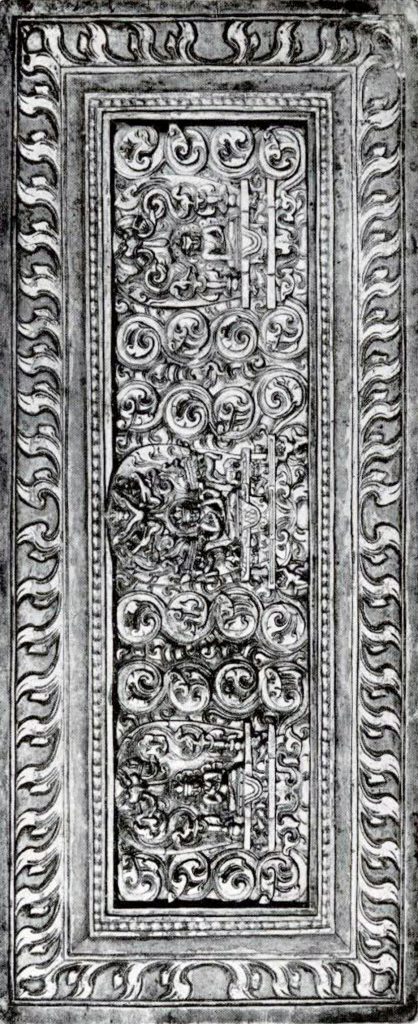
Museum Object Number: A1443
Image Number: 2162
Into the differences of technique in Orient and Occident it is impossible to go exhaustively here. One of the distinguishing features of all the best Oriental art, of course, is the mastery of the line, which commonly has a flow and rhythm and certainty rarely attained in the west. It is possible that this superior facility on the part of Asiatic artists may be explained, in part at least, on purely mechanical grounds. In the west it is customary to paint upon a more or less vertical surface, such as an easel or a wall afford, using the shoulder as the fulcrum upon which the artist’s brush hand moves. In Oriental painting the prepared silk or paper which is to receive the drawing is commonly laid flat, and the brush is held vertically, with the muscles of the forearm resting on the table, or floor, as the case may be. In this way the same kind of sweeping stroke or flourish may be used as that employed by our expert penmen, and a much more effective control of the brush be rendered possible.
In order to insure accuracy and to reduce the possibility of variations from the type sanctioned by age-long usage, the outlines of sacred paintings are first stenciled with powdered charcoal and then drawn in with ink. The colors as a rule are laid on flat, although attempts at shading are not unknown ; these usually occur, however, only on the accessories, such as ornaments and garments. In general, paintings are mounted somewhat after the manner of the book rolls of the ancient world. The rollers upon which the painting is fixed, often themselves of decorative materials such as ivory or ebony, serve to keep the picture flat when suspended. In many cases the painting proper has a border of blue, yellow, and red stripes of silk damask. Protection against dust and sunlight is achieved by suspending a thin silken veil from the upper roller. Certain rites and ceremonies are carried on in connection with the painting of a picture, for without these it can have no efficacy as an object of worship. These ceremonies must be kept up till the picture is entirely completed, as otherwise even at the last moment some evil spirit might take possession of it and render it worse than useless.
In the strict sense it is not correct to speak of gods in Buddhism, as beings distinct in essence from mankind or any other class of living creatures. In theory the beings worshiped are simply ones who, by their superior merits, have reached a stage on the way toward Nirvana far advanced, it is true, but still open to every living creature which will put forth the requisite effort toward right doing. In practice, however, especially in the popular mind, Buddhism, quite as much as any other religion, has its gods, some of them deified men, others personifications of abstract ideas, others still, simply primitive folk divinities taken over bodily by being identified—and undoubtedly in entire good faith—as reincarnations of this or that Buddhist character.
It is unknown when the Tibetans, then no doubt a barbarous, semi-nomadic race, first became cognizant of the faith which had sprung up beyond the mighty mountain barrier to the south of them. The sixth and seventh centuries of our era are perhaps the most important in all history as regards the development of the three great world religions. Eastern Asia, including China, Korea, Japan and Tibet, accepted Buddhism at that time; almost simultaneously western Asia and northern Africa became definitively Mohammedan; while the conversion of the Franks and the Anglo-Saxons and other pagan peoples of Europe by Italian and Irish missionaries ensured the winning of the west for Christianity. Legend says that a certain king, Srong-tsan Gampo by name, sent to India, about the year A.D. 632, the year of the death of Mohammed, for the double purpose of procuring sacred books and relics, and of securing a form of script adapted to the Tibetan language. To this episode must in all probability be ascribed the beginning not merely of Buddhism but of civilization in Tibet. That not all the credit can be given to India, however, is indicated both by an analysis of the elements of the existing Tibetan religion and culture and by the tradition that King Srong-tsan Gampo was assisted in his propaganda by his two wives, the one a Nepalese princess, the other a Chinese, but both ardent followers of the Buddha. These women so impressed themselves upon the life of their times that they are still revered as incarnations of the goddess Tara, the Chinese princess being regarded as the so-called ” white Tara,” and the Nepalese as the “green.”
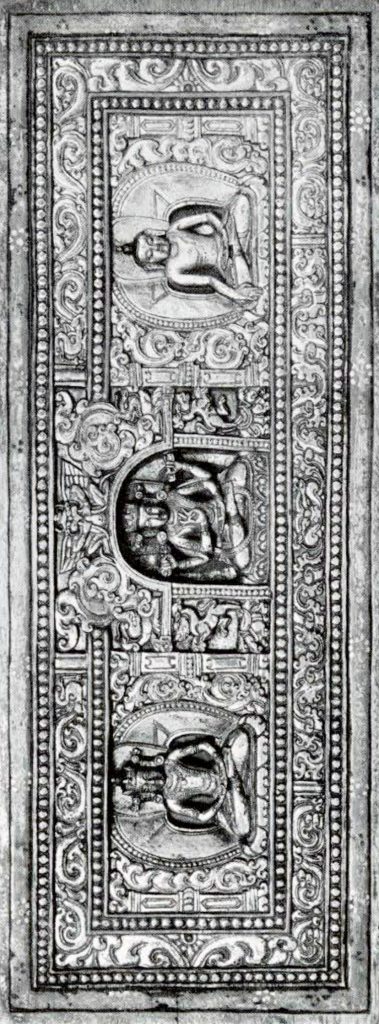
Museum Object Number: A1442
Image Number: 2161
Nevertheless the Buddhism of Tibet, commonly known as Lamaism, owes its characteristic forms and particularly its enormously complex mythology to India rather than to China. That this is the case is due in great measure to the teachings of the famous guru. or saint, Padma Sambhava (” the Lotus-born “), of Udyâna, a man undoubtedly of extraordinary force of personality, who. invited to Tibet by its king during the latter half of the eighth century, introduced many magical beliefs and practices and strongly impressed the popular faith with doctrines connected with Hindu Saivism or Siva worship. Siva forms one member of the Hindu trinity, his associates being Brahma and Vishnu. He represents especially the destructive forces of Nature; but inasmuch as death is looked upon merely as the transition to a new life, Siva, the Destroyer, is also regarded as a Re-creator. In pictorial representations he is usually painted white.
Another element in Lamaism which helps to differentiate it from the Buddhism of any other land is the survival of many of the primitive rites and ceremonies of the aboriginal shamans. It is this, in all probability, which is to be held chiefly accountable for the simpler and more savage features of Lamaism; such things, for example, as the beliefs in ghosts and local demons, or the predilection for trumpets, bowls, drums, and ceremonial aprons, of human bone. These aprons, as well as the other sacred utensils named, are made of the bones of deceased Lamas noted for holiness; it is believed that they are pleased by this use of their relics. See the MUSEUM JOURNAL, Vol. V, Fig. 64.
Fig. 97 is a representation of Padma Sambhava. Although without inscription or title of any kind, the identity of the personage depicted may be determined satisfactorily by his attributes.
The prevailing color of the painting is red in various shades, all now more or less toned down by time. The scarf or cloak of the guru is a dark red, spangled with gold rosettes; his mitre, a paler shade of the same hue. The fiery backgrounds of the Vajrapâni figures in the lower part of the picture are red also. In fact, this color occurs prominently in the persons, costumes, or backgrounds of every figure represented. Next in prominence is green, likewise in various shades, but all subdued in tone. This color appears in the leaf design forming the background, little of which, however, is visible, so completely is it overlaid with the different figures; it may be made out in the lower corners and along the sides, and less prominently elsewhere. The upper garment of the guru (that worn next under the scarf) is also green, as are the halo—the largest mass of solid color in the painting—and the central portion of the back plaque. White is also very effectively used, particularly in the mass of lotus blossoms supporting the pedestal upon which the central figure is seated. The faces, hands, and other visible portions of the persons of the saint and his two wives are of a pale flesh tint.
The teacher is shown seated in a crosslegged attitude, with the sole of the left foot resting upon a lotus thalamus. His mitre, of light red edged with green, is topped by a vulture’s feather, emblematic of the loftiness of his doctrines; the vulture being regarded as the highest and farthest flier among birds. The scarf, already described, is worn over the left shoulder in the manner traditional among Buddhist holy men, and flows down over his lap in a highly naturalistic way. In fact, drapery, wherever it occurs in this painting, is handled in a most able manner.
In his right hand the saint holds the sacred vajra (Tib. do-rje) or thunderbolt emblem, sometimes known as “the sceptre of Indra,” believed to ensure protection and the attainment of eternal life. In the other hand is grasped the skull bowl, containing either blood or amrita (literally “sweet dew “—the ambrosial food of the dêvas or supernatural beings), suggestive of blessings of various sorts. The trident, leaning against the left shoulder, signifies that the saint has overcome the Three Vices—Lust, Anger, Sloth; on the shaft appear a skull and the heads of a man and a child.
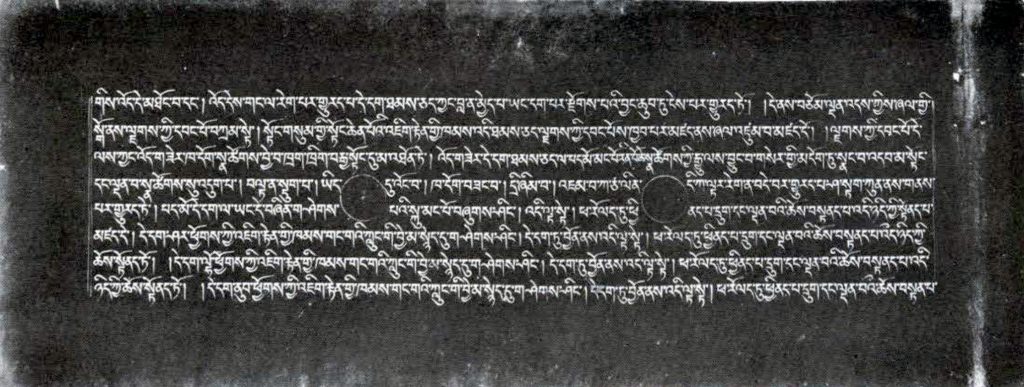
Museum Object Number: A1442
Image Number: 2160
Flanking the central figure of the painting are two female figures, in all probability the wives of the guru. They are represented as offering skull bowls filled with blood or amrita. The remainder of the space is filled with representations, on a smaller scale, of various personages of the Buddhist pantheon. As already noted, Buddhism knows no gods, properly speaking. The persons adored by its followers include Gautama (the historical Buddha) and his mythical forerunners and successors of like rank, Bodhisattvas, or individuals who have attained to within one degree of Buddhahood; and a vast body of spirits, deified priests, and folk divinities taken over from other religions. Notable among these are the Vajrapâni figures, nine times repeated, which occupy all that portion of the painting beneath the three central figures. These are embodiments of Indra, one of the most ancient gods of Brahminism, later adopted by Buddhism on account of his popularity. He is looked upon as protector of the Faith, and his emblem is the vajra, or thunderbolt. In rank, however, he is far subordinate to the Buddha and even to the Bodhisattvas, Indra is supposed to have been reborn as a Yaksha (or demon) king, in order the better to combat the foes of the Truth. Each of these representations is shown with four feet, six hands, and three faces, each face bearing three eyes. Although no two are colored quite alike, the central one of the group may be taken as typical of all the rest. In this instance the body and the middle one of the three faces are a deep red. The face to the left (of the beholder) is dark blue, while that to the right is a dead chalky white. What seems to be meant for the hair is indicated by a mass of spirals of a deep golden yellow, overarching all three of the faces. About the head is a coronet of skulls, and around the loins is a double girdle, the upper of skulls, the lower, of human heads. The figure wears a tiger skin apron and also a loin cloth consisting of a man’s skin, with head, hands and feet still attached. These may all be clearly made out in the picture; the head, in an inverted position, is visible just below the lowermost right elbow. In his hands Vajrapâni bears various articles—skull howl, do-rje, holy water vessel, sword and trident. The two last-named articles are scarcely to be made out in the reproduction, and indeed appear very indistinctly in the painting itself, being only lightly touched in with gold leaf, apparently after the rest of the picture was completed. They are borne, the trident in the middle left, the sword in the uppermost right hand. Clasped in his lowest pair of arms is Vajrapâni’s consort, or “feminine energy,” Cakti (Tib. Yum); she is represented of a light red color and bears in her left hand the skull bowl. Beneath the feet of the pair are various prostrate figures, representing the various foes conquered; in some instances these represent Hindu divinities. The other eight figures of the group, save for slight differences in the coloring and the attributes, are practically identical.
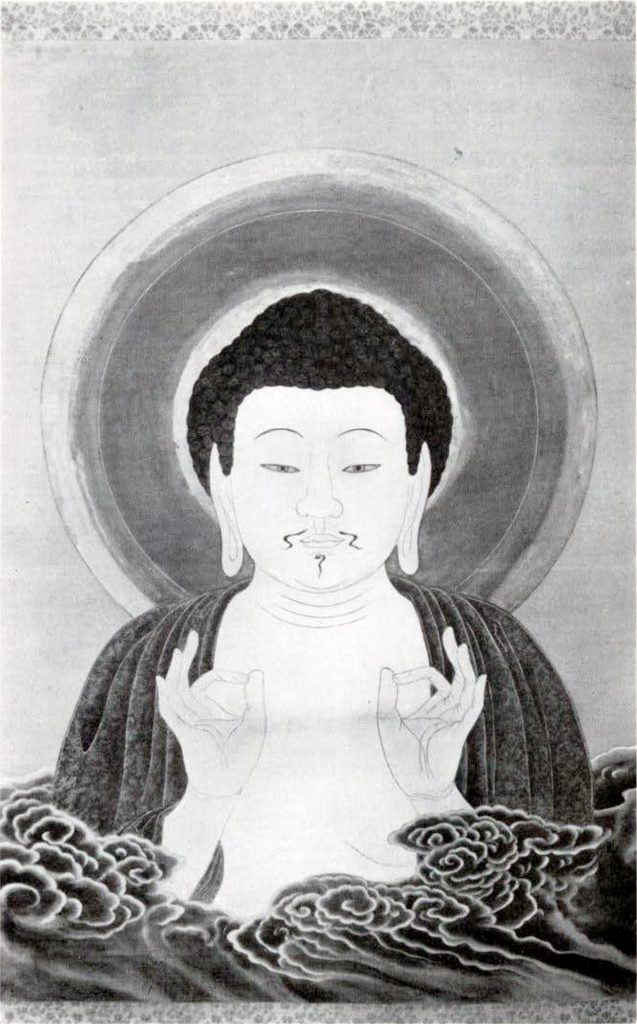
Museum Object Number: 29-198-4
Image Number: 2149
In each of the lower corners of the painting is a representation, in white, of a stûpa, the dagoba of Ceylon; originally a monument supposed to contain a relic of the Buddha. Inasmuch as the human body is believed to be composed of eighty-four thousand atoms, the legend asserts that King Asôka (B.C. 272-232), the Buddhist Constantine, erected eighty-four thousand stiipas in various parts of India, one for each of Shâkyamuni’s component atoms. Near the stûpa is a snake’s head, protruding from the leaf design forming the background of the picture. This snake’s head motif also occurs elsewhere in the picture.
The identification of the five personages of the picture represented in Fig. 96 would offer no difficulty, even were their attributes not shown, since each has his name or title appended in gilt lettering, in the graceful Tibetan script. This painting is apparently of considerable age, and the colors, once no doubt vivid and striking, have been toned down by time and the smoke of incense until the effect is suggestive of the mellowed richness of a fine old Oriental rug.
As in the first picture, the prevailing colors are red and green. Their distribution, however, is quite different, for here the warm tones are for the greater part retained for the various figures and their accessories, while the green is almost wholly relegated to the background.
Another point of difference is that the interest is not so strongly centered upon any one individual as is the case in the picture shown in Fig. 97. As a matter of fact, indeed, it might be said that instead of being a composition, this picture is in reality a group of five unrelated representations of Buddhist worthies. Such action as is represented on the part of any one figure is quite independent of that of any of the others. Each, too, has its own background, although no hard and fast line can be drawn between them; in the case of the three upper figures it consists of rocks and clouds and landscape motives, while in that of the two lower, smoke and flames are the elements.
To begin with the central figure, we have here a representation of Dharmatrâta, the seventeenth on the list of the eighteen Lo-han or disciples of Buddha. The saint is shown seated “European fashion” upon a sort of chair of red and gold covered with a cloth of the same hues which extends under the feet of the Lo-han. Over the head of the figure is a most peculiar sort of halo, resembling a circle of red ribbon with a graceful floral design in gold, and borders of green; it appears to be held in place by a curving arm rising from the back of the chair. Contrary to general usage, Dharmatrâta is shown with his head unshaven, and wears his hair in a heavy twist falling down over his left shoulder and giving him a strangely feminine look. His outer vesture is not the regulation scarf of the Buddhist priest, but a garment of medium length with long pendant sleeves, reminding one of the Japanese haori; it is buff colored, with a very heavy edging of blue bearing a running leaf and branch design in gold, and the sleeves disclose a lining of a soft, rich maroon. Beneath this is a long garment coming down to the feet, which in fact it partially covers, only the soles of the shoes being visible; it is a rich red, heavily brocaded with gold. In his left hand the saint holds a holy water vessel of the usual type,*without a handle of any sort, but with a long and gracefully curved spoilt; while in his right is a censer attached to a long stick; in the rolling clouds of pale rose colored smoke pouring from this appear two small conventional Buddhist figures. At the feet of the saint lies a tiger, curled up as if asleep, but with wide open, staring eyes.
The two figures in the upper corners also represent Sthaviras. That to the observer’s right is, as his inscription declares, the sixteenth of the group, called by the Tibetans Mi-byed-pa (or Mi-p’-yed-pa; the Sanskrit equivalent for this name is .riot known). He is shown seated upon a rather elaborate throne of red and gold, with green panels bearing a floral design; his bare feet rest upon a square green-topped footstool. Overhead is a tree thickly covered with broad leaves and laden with fruit ; curiously enough, some of the leaves extend over the edge of the circular red halo, giving the latter exactly the effect of a setting sun. It is difficult to see exactly what the artist’s conception of the nature of the halo was; apparently he thought of it as an actual, material disc, quite detached from the person of the saint—so much so, indeed, that objects might pass between. The Lo-han has his head shaven and wears the regulation priestly scarf over his left shoulder, while in his hands he holds his customary attribute, a miniature stûpa. In front of him kneels a bearded figure representing a Turk or an Iranian, offering to the saint a bowl filled with jewels.
The somewhat similar scene depicted in the upper left-hand corner had to do with the Arhat Gopa (Tibetan sBed-byed; this name appears, in barely legible Tibetan script, beneath the picture), the fifteenth of the series. He is shown seated crosslegged upon a red cloth worked with gold, and holding in both hands his usual attribute, a book containing portions of the sacred writings, green covered and oblong in shape. Examples of the teakwood covers of these books, now on exhibition in the Museum, date probably from about the sixteenth century; they are most elaborately carved and are finished in red lacquer heavily overlaid with gold. His halo is of a pale maroon color. In front of him stands a turbaned and bearded individual clad in a long robe, holding before him a carrying pole from which he has just taken an offering of precious stones, which now repose in a rather deep bowl to the saint’s right.
The two figures against flaming backgrounds in the lower corners of the painting represent two of the four Guardians of the World (Lôkapâla), or Great Heavenly Kings, who guard the mountain Sumeru (the center of the Universe, according to the Buddhist system) against the attacks of demons; for this reason they are depicted wearing complete armor and rolling their eyes horribly, in order to alarm the enemy. The one to the right is the God of Wealth, Kubera or Vâiçravana, the Guardian of the North. His favorite color being yellow, his face and hands are depicted of that color; fringing his very full cheeks is a thin beard. In his right hand he grasps a banner; in his left, an ichneumon. In India snakes are believed to act as guardians of hidden treasure, and the ichneumon, by devouring snakes, becomes possessed of the jewels guarded by them; hence it is considered a fit emblem of the God of Wealth.
In the left-hand corner is Virûpâksha, Guardian of the West and King of Nâgas; his favorite color being red, his face and hands are of that color. He too has a slight fringe of beard, and in his right hand he holds his attribute, a miniature stûpa.
The foregoing are only a few of the more striking of the very many features in these two paintings which offer themselves for discussion. They are perhaps sufficient, however, to show how complex, both in origin and in distinguishing characteristics, is the art of the Lamas—the product, as it is, of three principal factors, Indian, Chinese, and Tibetan. Thus the faces of the persons depicted in these two paintings have in almost no case the least resemblance to the type of countenance known as mongoloid, which includes both the Chinese and the Tibetan groups. On the contrary, it is Indian, with a touch of Greek influence showing in some cases. Yet the straggling beards of the two Lôkapâlas (Fig. g6) and the tiny moustache of Padma Sambhava (Fig. 97) are distinctly Mongolian, while India is a land of magnificent beards. The same mingling of influences might be even more easily demonstrated in the costumes. In a very general way it may be said that the concepts illustrated are Indian in origin, while the technique is Chinese; but that both concepts and technique have been so thoroughly modified by aboriginal ideas that the resultant is neither Indian nor Chinese, but Tibetan, forming one of the best marked and most strongly individualized subdivisions of the great field of Buddhist religious art.
C. W. B.
- *Some excellent specimens of this type are now on exhibition in the Museum; see MUSEUM JOURNAL, Vol. V, No. 2, Fig. 48.

